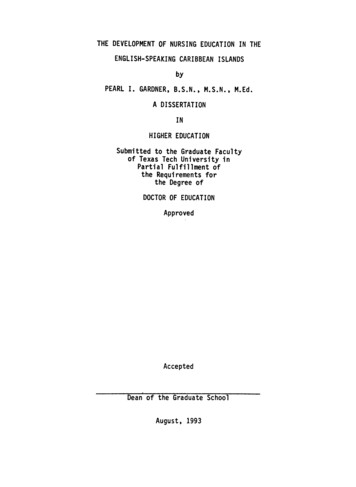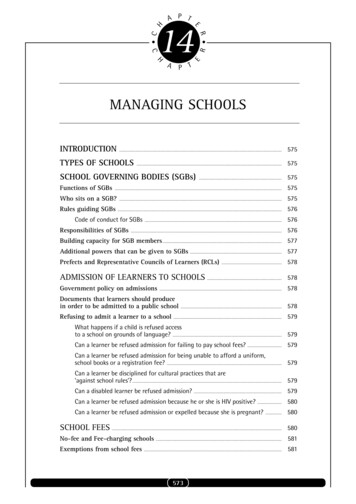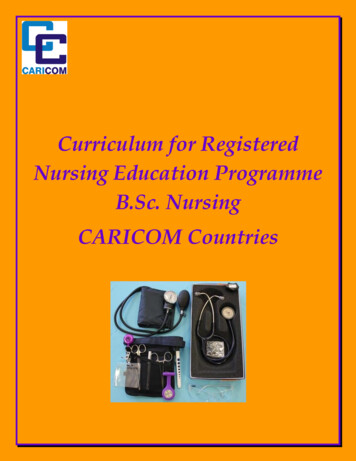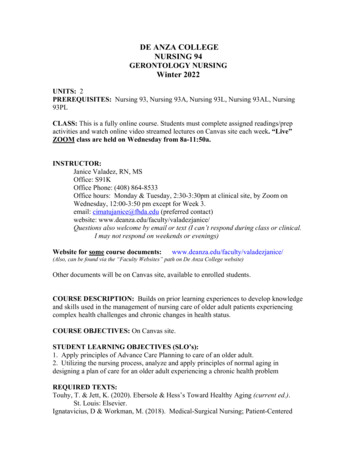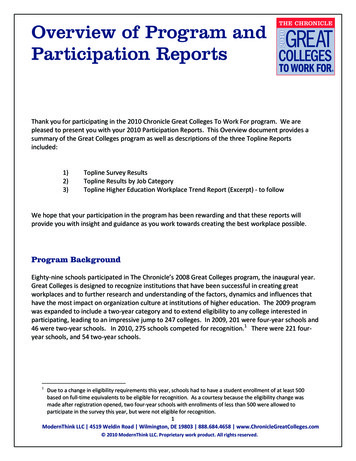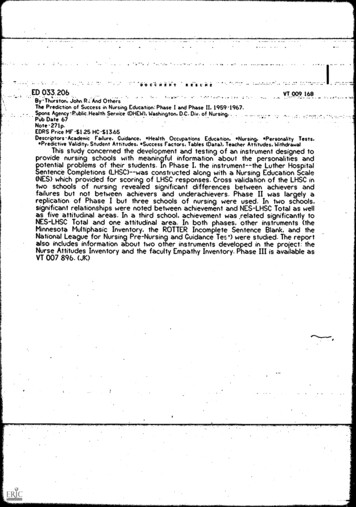
Transcription
,.VOCLMENTED 033.206.NEIVPIEVT 009 168By -Thursion. John R.: And OthersThe Prediction of Success in Nursing Education: Phase I and Phase II. 1959-1967.Spons Agency 7P.ublic.Health Service (DREW). Washington. D.C. Div. of Nursing. .7 "Pub Date 67Note -271p.EDRS Price MF - 125 HC- 13.65Descriptors-Academic Failure. Guidance. Health Occupations Education. Nursing. Personality Tests.Predictive Validity. Student Attitudes. Success Factors. Tables (Data). Teacher Attitudes. WithdrawalThis study concerned the development and testing of an instrument designed toprovide nursing schools with meaningful information about the personalities andpotential problems of their students. In Phase I. the instrument -the Luther HospitalSentence Completions (LHSC)--was constructed along with a Nursing Education Scale(NES) which provided for scoring of LHSC responses. Cross validation of the LHSC intwo schools of nursing revealed significant differences between achievers andfailures but not between achievers and underachievers. Phase II was largely areplication of Phase I but three schools of nursing were used. In two schools.significant relationships were noted between achievement and NES-LHSC Total as wellas five attitudinal areas. In a third school. achievement was !elated significantly toNES-LHSC Total and one attitudinal area. In both phases. other instruments (theMinnesota Multiphasic Inventory. the ROTTER Incomplete Sentence Blank. and theNational League for Nursing Pre-Nursing and Guidance Tee') were studied. The reportalso includes information about two other instruments developed in the project: theNurse Attitudes Inventory and the faculty Empathy Inventory. Phase III is available asVT 007 896. (JK).
THE PREDICTION OF SUCCESS IN NURSING EDUCATIONComprehensive Report: Phase I and Phase II1959 -1967Manual for LHSC and NSCJOHN R. THURSTON, Ph. D.Wisconsin State University, Eau Claire, WisconsinHELEN L. BRUNCLIK, R.N., M.N.St. Joseph's School of Nursing, Marshfield, WisconsinJOHN F. FELDHUSEN, Ph. D.Purdue University, Lafayette, Indiana
r.THE PREDICTION OF SUCCESS IN NURSING EDUCATION:PHASE I AND PHASE II)1959-1967A Manual for the Luther Hospital Sentence Completionsand the Nursing Sentence CompletionsJohn. R. Thurston, Ph. D.Wisconsin State University - Eau Claire, WisconsinHelen L. Brunclik, M. N.St. Joseph's Hospital School of NursingMarshfield, WisconsinJohn F. Feldhusen, Ph.D.Purdue UniversityLafayette, IndianaU.S. DEPARTMENT OF HEALTH, EDUCATION & WELFAREOFFICE OF EDUCATIONTHIS DOCUMENT HAS BEEN REPRODUCED EXACTLY AS RECEIVED FROM THEPERSON OR ORGANIZATION ORIGINATING IT.POINTS OF VIEW OR OPINIONSSTATED DO NOT NECESSARILY REPRESENT OFFICIAL OFFICE OF EDUCATIONPOSITION OR POLICY.This investigation was supported by Public Health ServiceResearch Grant NU 00018-07 from the Division of Nursing,Bureau of State Services, National Institutes of Health;United States Department of Health, Education, and Welfare.Sponsor: Luther Hospital, Eau Claire, Wisconsin1967
iiiACKNOWLEDGEMENTIt is obvious that a project like this could not have been carried outwithout the interest and cooperation of the participating schools. Therefore, our particular thanks go to the administration, faculty, and studentsof these institutions:Bryn Mawr School of Nursing, Bryn Mawr, PennsylvaniaCalifornia Hospital School of Nursing, Los Angeles, CaliforniaEmanuel Hospital School of Nursing, Portland, OregonHenry W. Bishop 3rd Memorial School of Nursing, Pittsfield, MassachusettsHoly Family Hospital School of Nursing, Manitowoc, WisconsinJackson Memorial Hospital School of Nursing, Miami, FloridaLuther Hospital School of Nursing, Eau Claire, WisconsinLutheran Hospital School of Nursing, Cleveland, OhioMadison General Hospital School of Nursing, Madison, WisconsinMercy Hospital School of Nursing, New Orleans, LouisianaNebraska Methodist School of Nursing, Omaha, NebraskaPurdue University Nursing Section, Lafayette, IndianaRegina School of Nursing, Albuquerque, New MexicoSt. Joseph's Hospital School of Nursing, Marshfield, WisconsinSt. Vincent's Hospital School of Nursing, New York, New YorkWe also wish to express special appreciation to:Arne Sorlien, Lester Missman, and the administrative personnel ofLuther Hospital for their assistance in management of the researchgrant funds;Joseph Lucas, a student at Wisconsin State University - Eau Claire, andDavid Starks, a graduate student at Purdue University, who contributedso much by scoring tests and preparing data for the computer analysis;Mary Rosolack for her unending patience in deciphering corrected copyand typing the final manuscript;and to Miss Stahl and the staff of the Wisconsin Department of Nurses, tothe directors of Wisconsin schools of nursing and to nursing educatorsand researchers everywhere, who by their interest, inquiries, andcomments have demonstrated their belief in our work.John R. ThurstonHelen L. BrunclikJohn F. Feldhusen
vCONTENTSPageAcknowledgementiiiList of TablesviiList of FiguresxviCHAPTER1Nursing Student Attrition2An Overview of the Research Design: Phases I and II153The Minnesota Multiphasic Personality Inventory274The Rotter Incomplete Sentence Blank (ISB)715The Luther Hospital Sentence Completions (LHSC)836Nursing Sentence Completions (NSC)1297Nurse Attitudes Inventory (NAI), Forms I and II1378Nursing Education Scale (NES)1499Relationships Among Performance on LHSC, NSC, andNAI as Scored with the NES1551Discriminant Function and the Prediction of NursingStudent Achievement163Empathy Inventory (EI)173Summary of Phase I and II185APPENDIXAppendix AA-1Appendix BB-1Appendix CC-1
viiList of TablesPageTableMean Pre-Admission MMPI L Scale Scores By Achievement Status and Nursing School Affiliation for 445 SecondYear Nursing Students313.2Differences Between Means for Achievement Groups andNursing Schools on the Pre-Admission MMPI Lie Scale323.3Analysis of Variance for Pre-Admission MMPI Lie ScaleScores333.4Mean Pre-Admission MMPI F Scale Scores by Achievement Status and Nursing School Affiliation for 445 SecondYear Nursing Students343.5Differences Between Means for Achievement Groups andNursing Schools on the Pre-Admission MMPI F Scale353.6Analysis of Variance for Pre-Admission MMPI F ScaleScores363.7Mean Pre-Admission MMPI K Scale Scores by Achievement Status and Nursing School Affiliation for 445 SecondYear Nursing Students373.8Differences Between Means for Achievement Groups andNursing Schools on the Pre-Admission MMPI K Scale383. 9Analysis of Variance for Pre-Admission MMPI K ScaleScores39Mean Pre-Admission MMPI Hypochondriasis Scale Scoresby 'Achievement Status and Nursing School Affiliation for445 Second Year Nursing Students40Differences Between Means for Achievement Groups andNursing Schools on the Pre-Admission MMPI Hypochondriasis Scale41Analysis of Variance for Pre-Admission MMPIHypochondriasis Scale Scores423.13.103.113.12
viiiTable3.13Mean Pre-Admission MMPI Depression Scale Scores byAchievement Status and Nursing School Affiliation for445 Second Year Nursing Students3.14Differences Between Means for Achievement Groups andNursing Schools on the Pre-Admission MMPI DepressionScale3.15Analysis of Variance for Pre-Admission MMPI DepressionScale Scores3.16Mean Pre-Admission MMPI Hysteria Scale Scores byAchievement Status and Nursing School Affiliation for445 Second Year Nursing Students3.17Differences Between Means for Achievement Groups andNursing SchoAs on the Pre-Admission MMPI HysteriaScale3.18Analysis of Variance for Pre-Admission MMPI HysteriaScale Scores3.19Mean Pre-Admission MMPI Psychopathic Deviate ScaleScores by Achievement Status and Nursing School Affiliationfor 445 Second Year Nursing Students3.20Differences Between Means for Achievement Groups andNursing Schools on the Pre-Admission MMPI PsychopathicDeviate Scale3.21Analysis of Variance for Pre-Admission MMPI Psychopathic Deviate Scale Scores3.22Mean Pre-Admission MMPI Masculinity-Femininity ScaleScores by Achievement Status and Nursing School Affiliationfor 445 Second Year Nursing Students3.23Differences Between Means for Achievement Groups andNursing Schools on the Pre-Admission MMPI MasculinityFemininity Scale3.24Analysis of Variance for Pre-Admission MMPIMasculinity-Femininity Scale Scores54
ixPageTable3.253.263. 273. 283.293. 303. 313. 323.333. 343. 353. 36Mean Pre-Admission MMPI Paranoia Scale Scores byAchievement Status and Nur sing School Affiliation for445 Second Year Nursing S tudents55Differences Between Means for Achievement Groups andNursing Schools on the Pre-Admission MMPI ParanoiaScale56Analysis of Variance for Pre-Admission MMPI ParanoiaScale Scores57Mean Pre-Admissi on MMPI Psychasthenia Scale Scores byAchievement Stat s and Nursing School Affiliation for 445Second Year Nur sing Students58Differences Be tween Means for Achievement Groups andNursing Schoo is on the Pre-Adm.;.:2sion MMPIPsychastheni a Scale59Analysis of Variance for Pre-Admission MMPIPsychasth enia Scale Scores60Mean Pr e-Admission MMPI Schizophrenia Scale Scores byAchieve ment Status and Nursing School Affiliation for 445Second Year Nursing Students61Diffe rences Between Means for Achievement Groups andNur sing Schools on the Pre-Admission MMPISc izophrenia Scale62Analysis of Variance for Pre-Admission MMPISchizophrenia Scale Scores63Mean Pre-Admission MMPI Hypomania Scale Scores byAchievement Status and Nursing School Affiliation for445 Second Year Nursing Students64Differences Between Means for Achievement Groups andNursing Schools on the Pre-Admission MMPI HypomaniaScale65Analysis of Variance for Pre-Admission MMPIHypomania Scale Scores66
xPageTableMean Pre-Admission MMPI Socia 1 Introve r sionExtraversion Scale Scores by Ac hievement Status andNursing Affiliation for 445 Seco nd Year Nursing Students67Differences Between Means for Achievement Groups andNursing Schools on the Pre-Admission MMPI SocialIntroversion-Extraversion Scale68Analysis of Variance for Pre-Admission MMPI SocialIntroversion-Extraversi on Scale Scores69Mean Pre-Admission Rotter ISB Scores by AchievementStatus and Nursing S chool Affiliation for 445 Second YearNursing Students79Differences Betw een Means for Achievement Groups andNursing Schools on Pre-Admission Rotter ISB804.3Analysis of Va riance for Pre-Admission Rotter ISB Scores815.1Inter-Scorer Correlations of NES Total Scores from Seven3.373.383.394.14.25.25.35.45.55 .65.7Scorings of 50 LHSC'S104Analysis of Variance and Reliability Estimate for NESTotal Sc ores of 7 Scorers of 50 LHSC'S104Test- Retest Correlations of NES-LHSC Total and AreaScor es (N 104)105Mean Nursing NES-LHSC-Area Scores by AchievementStatus for 445 Second Year Nursing. Students at ThreeSchools of Nursing106Differences Between Means for Achievement Groups andSchools of Nursing on Pre-Admission NES-LHSC-AreaScores107Analysis of Variance for Pre-Admission Nursing NESLHSC-Area Scores at Luther Hospital and Holy FamilyHospital Schools of Nursing108Analysis of Variance for Pre-Admission Nursing NESLHSC-Area Scores at Madison General Hospital School'of Nursing108
xiPageTableMean Self NES-LHSC-Area Scores by AchievementStatus for 445 Second Year Nursing Students at ThreeSchools of Nursing109Differences Between Means for Achievement Groups andSchools of Nursing on Pre-Admission Self NES-LHSCArea Scores110Analysis of Variance for Pre-Admission Self NES-LHSCArea Scores at Luther Hospital and Holy Family HospitalSchools of Nursing1115.11Analysis of Variance for Pre-Admission Self NES-LHSCArea Scores at Madison General Hospital School of Nursing1115. 12Mean Home-Family NES-LHSC-Area Scores by AchievementStatus for 445 Second Year Nursing Students at Three Schoolsof Nursing112Differences Between Means for Achievement Groups andSchools of Nursing on Pre-Admission Home-FamilyNES-LHSC-Area Scores113Analysis of Variance for Pre-Admission Home-FamilyNES-LHSC-Area Scores at Luther Hospital and HolyFamily Hospital Schools of Nursing1145. 85. 95.105.135.145.155.165.175.18Analysis of Variance for Pre-Admissinn Home-FamilyNES-LHSC-Area Scores at Madison General HospitalSchool of Nursing114Mean Responsibility NES-LHSC-Area Scores by Achievement Status for 445 Second Year Nursing Students at ThreeSchools of Nursing115Differences Between Means for Achievement Groups andSchools of Nursing on Pre-Admission ResponsibilityNES-LHSC-Area Scores116Analysis of Variance for Pre-Admission ResponsibilityNES-LHSC-Area Scores at Luther Hospital and HolyFamily Hospital Schools of Nursing117
285.29Analysis of Variance for Pre-Admission ResponsibilityNES-LHSC-Area Scores at Madison General HospitalSchool of Nursing117Mean Other-Love-Marriage NES-LHSC-Area Scores byAchievement Status for 445 Second Year Nursing Studentsat Three Schools of Nursing118ifferences Between Means for Achievement Groups andSchools of Nursing on Pre-Admission Other-Love-MarriageNES-LHSC-Area Scores119Analysis of Variance for Pre-Admission Other-LoveMarriage NES-LHSC-Area Scores at Luther Hospital andHoly Family Hospital Schools of Nursing120Analysis of Variance for Pre-Admission Other-LoveMarriage NES-LHSC-Area Scores at Madison GeneralHospital School of Nursing120Mean Academic NES-LHSC-Area Scores by AchievementStatus for 445 Second Year Nursing Students at ThreeSchools of Nursing121Differences Between Means for Achievement Groups andSchools of Nursing on Pre-Admission Academic NESLHSC-Area Scores122Analysis of Variance rfor Pre-Admission Academic NESLHSC-Area Scores at Luther Hospital and Holy 'FamilyHospital Schools of Nursing123Analysis of Variance for Pre-Admission Academic NESLHSC-Area Scores at Madison General Hospital Schoolof Nursing123Mean Total NES-LHSC Scores by Achievement Status for445 Second Year Nursing Students at Three Schools ofNursing124Differences Between Means for Achievement Groups andSchools of Nursing on Pre-Admission Total NES-LHSCScores125
PageTableAnalysis of Variance for Pre-Admission Total NES-LHSCScores at Luther Hospital and Holy Family HospitalSchools of Nursing1265.31Analysis of Variance for Pre-Admission Total NES-LHSCScores at Madison General Hospital School of Nursing1265.32Pre-Admission NES-LHSC Total Scores by AchievementStatus at Three Schools of Nursing for 445 Second Year5.30Students1276.1Inter-Scorer Correlations of NES'NSC Total Scores fromSix Scorings of 36 NSC'S1346.2Analysis of Variance and Reliability Estimate for NES-NSCTotal Scores of Six Scorings of 36 NSC'S1346.3Test-Retest Correlations of NES-NSC Total and Area7.18.1Scores (N 56)Test-Retest Correlations of NES -NAT Total and AreaScores (N 63)Correlations of NES Item Scores with Area and TotalScores on the Basis of 223 NSC's Administered at SixSchools of Nursing9.1Correlations of Total and Area Scores of NES-LHSC and9.2Correlations of Total and Area Scores of NES-LHSC and9.3Correlations of Total and Area Scores of NES-NAI and9.4Correlations of Total and Area Scores of NES-NSC and10.1NES-NSC Scorings (N 99)NES-NSC Scorings (N 33)NES-LHSC Scorings (N 33)135147154158159160NES-NAI Scorings (N 162)161Actual Achievement Compared to Achievement Identifiedby Discriminant Function for 110 Students at LutherHospital School of Nursing168
xivTable.10.210.310.4PageAccuracy Of Identification Using Past Experience orDiscriminant Function Analysis at Luther HospitalSchool 'of Nursing168Actual Achievement Compared to Achievement Identifiedby Discriminant Function for 88 Students at Holy FamilyHospital School of Nursing169Accuracy of Identification Using Past Experience orDiscriminant Function Analysis at Holy Family HospitalSchool of Nursing16910.5Actual Achievement Compared to Achievement Identifiedby Discriminant Function for 247 Students at MadisonGeneral Hospital School of Nursing10.6Accuracy of Identification Using Past Experience orDiscriminant Function Analysis at Madison GeneralHospital School of Nursing10.7Actual Achievement Compared to Achievement Identifiedby Discriminant Function for Three Schools of NursingCombined10.8Accuracy of Identification Using Past Experience orDiscriminant Function Analysis for Three Schools ofNursing Combined11.1Empathy Inventory (EI) Scores and Percentiles forDifferent Groups12.1Mean Total NES-LHSC Scores by Achievement Status for445 Second Year Nursing Students at Three Schools ofNursing12.2Differences Between Means for Achievement Groups andSchools of Nursing on Pre-Admission Total NES-LHSCScores12.3Analysis of Variance for Pre-Admission Total NES-LHSCScores, at Luther Hospital and Holy Family HospitalSchools of Nursing
Table12.4Analysis of Variance for Pre-Admission Total NES-LHSCScores at Madison General Hospital School of Nursing
xviList of FiguresPageFigurePredispositions and Precipitations Involved in Success orFailure of Student NursesErratapage 98line 37 should read:"between Achievers vs. Underachievers, and Achieversvs. Failures. There"page 100lines 24 and 25 should read:"scores were noted in comparing the achievers withunderachievers as well as with failures.Inconsidering the attitude areas, only Home-Family"page 188lines 19 and 20 should read:"Total scores between achievers and failuresand between achievers and underachievers"174
-1Chapter 1Nursing Student Attrition*IntroductionThe 1963 Surgeon General's report, Toward Quality in Nursing: Needsand Goals, outlined the immensity of the current and developing demands uponthe nursing profession. The recommendations and projections included withinit furnish the basis and rationale for organized attempts to meet these needs,as well as the criteria by which the success of such efforts may be judged.The report is an important contribution which will have an impact on the profession for years to come.However, one significant area was given little emphasis in this report.Only one short paragraph (p. 12) and a footnote (p. 20) were devoted to theproblem of failure and withdrawal among nursing students. It was noted thatabout one-third of students who enter nursing schools do not graduate and, thatthis rate had held for many years. Furthermore, the report stated that therehad been no comprehensive studies of the problem since 1947. When one considers the progressive tenor of the rest of the report, the brevity of thiscommentary is difficult to understand. It seemed to reflect the pessimisticposition that nursing student attrition was inescapable -- that the "fallout" rateof approximately one-third is to be expected by nursing schools as inevitablyas "death and taxes".The published psychological studies of this problem may support thisessentially dour point of view (Taylor, 1963). However, it seems that theproblem of student withdrawal must be stressed, for the success with whichit can be handled will have a direct and important influence on whether thegoals of the Surgeon General's report can be realized. Accordingly, it appearsworthwhile to devote some discussion to the factors associated with failure orsuccess in nursing education as they relate to the recommendations of thisreport, with special reference to those factors involving recruitment of nursingstudents.Need for Greater RecruitmentIntensive and extensive recruitment is advocated by the Surgeon General'sreport as one answer to the need for more and better nurses. To state itsimply, in order to graduate more, it is helpful to enroll more. If enough*Substantial elements of this chapter were reported in an article: Brunclik,H. L. and Thurston, J. R. , "Nursing Student Attrition", Nursing Outlook,1965, 13, 57-59.
-2pplicants are recruited, it is possible that the required number of graduatenurses might be available in spite of a student withdrawal rate of approximatelyone-third. The money spent on academic failures and dropouts may have to beviewed as a necessary cost of nursing education.A very heavy burden of likely failures would have to be carried by theschools in order to insure that a substantial number will graduate. Indeed,this may be necessary, since the need for nurses is enormous. The SurgeonGeneral's report states that a total of 100, 000 graduates of basic professionalschools would be needed annually, beginning in 1966, to meet hospital staffneeds. However, only about 50, 000 students are admitted annually to theseschools. Of these, approximately 35, 000 are graduated. In keeping withthese facts, the Surgeon General's report indicates that a goal of 53, 000 graduates annually is possible, with 1969 as a more reasonable date for itsrealization.Several basic questions may be raised about recruiting in terms of agoal of even this magnitude. First of all, who is going to supply the considerable effort needed for recruitment? In following the recommendations, nursingschool faculties might be forced to give an undue amount of time to recruitingactivity -- time they should be devoting to the instruction and counseling oftheir students. Perhaps an increasing share of the responsibility for recruiting should be shifted to the nurses in the community. If properly prepared,oriented, and guided, such community nurse recruiters could constitutereliable, efficient, and persuasive sources of information regarding nursing asa career. The responsibilities and duties of recruiting may be so great as torequire the services of full-time, specialized recruiters who would go fromcommunity to community doing whatever would be necessary to interest capable students in nursing as a career.Second, and perhaps more important, will increased recruiting activitiesproduce students who will become the high caliber professional nurses advocatedin the Surgeon General's report? It seems likely that there are highly capableyoung men and women who are not now interested in nursing, but who mightdevelop an interest if they were properly approached. There is some suggestion that nursing schools are getting a decreasing share of the students graduating from high school. Thus, it would appear that high school counselingmust be markedly strengthened. Klemer (1964) makes recommendations forupdating and improving the high school counselor's knowledge of nursing. Ifthese counselors are better able to depict the role of nurses, with an accuratestatement of advantages and rewards, then some talented students, whomight not otherwise do so, may go into nursing.Lastly, how many students must be recruited and admitted to producethe proposed number of graduate nurses? If three students must now beadmitted to allow graduation of two nurses, how many would have to be admittedto gain the approximate doubling of output to four nurses by 1969? If the recruiting is extremely effective, and the most intelligent, best prepared studentsare convinced of the desirability of nursing as a career, it might be possibleto maintain, or even improve, the ratio of admitting six students to obtain fourgraduate nurses.
To get increased numbers of students, however, the recruiters in thishighly competitive situation will probably have to tap sources of students whoare generally less capable, less interested, or less well informed than the itstudents currently admitted to nursing schools. If this becomes the case,might be necessary to admit seven, eight, or even nine students in order toobtain the desired four graduates.Importance of Failure WithdrawalOther emerging trends conspire to increase the failure-withdrawal rate.The Surgeon General's report indicates that the intellectual and motivationaldemands on nursing students will continue to grow. There is reason to believethat the profession will require the baccalaureate degree, and perhaps themasters degree, for the professional nurse of the very near future. Thelengthening of the educational period and the increasing difficulty of nursingschool curriculums should tend to increase the proportion of students failingor withdrawing, even if their capability and motivational levels remain constant.Although it becomes complicated, it is necessary to consider the interaction of the combined effects of many forces on the student attrition rate, forexample, the increasingly greater demands placed on students who may ingeneral be less capable of succeeding. The question concerning the ratio ofadmissions to graduates should be asked again. If three students must nowbe admitted to allow graduation of two nurses, how many might have to beadmitted to gain the approximate doubling of output to four nurses by 1969?With increasing demands in the face of decreasing student capability, thisfigure might rise to ten or more. Such a student attrition rate -- in excessof 60 per cent -- is frightening to contemplate in terms of the financialexpense to the schools, the demoralizing effect on the faculties, and thepsychological trauma to the many students involved.In view of these gloomy possibilities, the nursing profession shouldexplore exhaustively every conceivable source of capable students for itsprograms. As the Surgeon General's report suggests, married students,older students, men students, and students from minority groups would constitute important target populations for recruitment.One highly important and available resource for graduate nurses wasoverlooked in the report. These are the students who withdraw from or failin schools of nursing. There are many factors to argue in favor of increasedattention to this group.First of all, there are a great many students in this category. Second,these students have sufficient intellectual-educational credentials to allowthem to pass the current admission standards of schools of nursing. Third,their motivation is sufficient to cause them to enroll in a school of nursing.And fourth, there is evidence that many who withdraw or fail do so for reasonsthat are only dimly understood at present, but which have little to do with asimple lack of ability or motivation. In short, as a group they have many
positive characteristics that might not be found as frequently or as readily inthe additional students enrolled through an expanded recruitment program.Students with these positive characteristics, but also with a potential for failureor withdrawal, should receive prime consideration in any effort aimed at increasing the number of graduate nurses.Alleviation of Student AttritionIn considering student failures and withdrawals, it would seem thatattention and research should be focused on those associated factors whichare most amenable to constructive change.In the area of student selection and education, there is evidence thatspecific units of instruction, or courses, require quite specific aptitudes andprior learnings if a student is to succeed in mastering their content. Greatlyimproved diagnostic testing involving these prerequisites is called for inorder to provide a basis for offering preventive or remedial instruction tothose students most likely to experience difficulty. Such instruction shouldbegin before the students have begun to demonstrate their incapacities byfailure in coursework and on the hospital wards. Faculty counselors, alertedto such students on the basis of test findings, would be in a position to recommend or provide special assistance at an early, optimal time. A nursingschool must provide training and time for the counseling function in recognitionof the fact that counseling constitutes an important responsibility of its facultymembers.In relation to the intellectual-educational factors which are related tostudent success in nursing education, there should be a studied attempt todefine more precisely the professional skills and attributes required of anurse. These considerations could then be used as the basis for reconsideration of the objectives and content of nursing education programs. At present,the goals of instruction and experience often seem rather vaguely defined andnot too well related to the eventual, diverse demands placed upon the professional nurse. Some progress in this direction has already been reported inestablishing an effective means of evaluating the clinical performance ofstudents (Hazeltine and Zeitz, 1964).Motivation toward nursing, personality, and social factors should alsorequire increased attention. If nursing education is required as multi-facetedlearning experience, then nursing schools should properly be concerned withthese factors as they relate to the student's ultimate functioning as a professional person. Increased attention should be devoted to psychological trainingand the development of tests designed to enhance faculty members' understanding of student personality and adjustment difficulties.Looking at the various circumstances within schools which might precipitate failure or withdrawal, the recommendations for change become moredifficult. Two of these, the academic and clinical demands, seem destinedfor continuing increases which will almost inevitably lead to increased studentattrition. No constructive purpose could be served by suggesting that these
- 5-demands be reduced. In terms of two other factors operating within theschool -- the impact of individual faculty members and the psycho-socialclimate of the school -- it is recommended that in-service programs fornursing school faculties might explore the problems in these areas whichaffect student performance (Thurston, Brunclik and Finn, 1962). One objective to these meetings would be to help the individual faculty member developfurther in her capacity to help students, in and outside the classroom orward, accomplish the fundamental iearnings which are required for successin nursing. Research into the complicated factors involving faculty andschool is clearly needed. Fox and others (1964) have identified characteristics of individual faculty members which were related to nursing studentsatisfaction and stress.There will be some who will be more impressed by the cost and thedifficulties of implementing such recommendations involving nursing educationthan by the rationale underlying the need for them. The suggested c
Jackson Memorial Hospital School of Nursing, Miami, Florida Luther Hospital School of Nursing, Eau Claire, . Mercy Hospital School of Nursing, New Orleans, Louisiana Nebraska Methodist School of Nursing, Omaha, Nebraska Purdue University Nursing Section, Lafayette, Indiana. Regina School of Nursing, Albuquerque, New Mexico.
